Cardinals created by Pius XII
Pope Pius XII (r. 1939–1958) created 56 cardinals in two consistories. On both occasions Pius tried to bring the membership of the College of Cardinals to 70, the maximum established by Pope Sixtus V in 1586.[1] The death of one cardinal meant his first consistory brought the College to 69 members, but his second consistory, through the prompt addition of another name after a cardinal-designate died, brought the number of cardinals to 70.
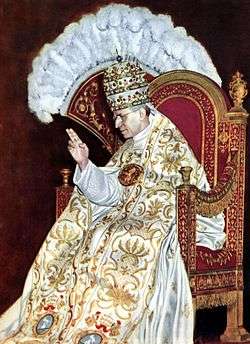
Pius was elected in 1939 by a papal conclave in which 62 cardinals participated. The Second World War forced him to wait until 1946 to hold a consistory to create cardinals. He then waited seven years as the membership of the College fell to 46 before holding another consistory in 1953, and it had fallen to 55 when he died five and a half years later without holding another consistory.
He named one cardinal who later became pope, Pope John XXIII.
18 February 1946
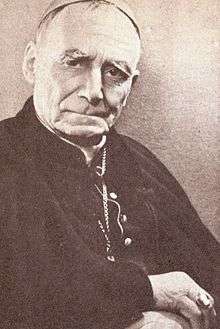
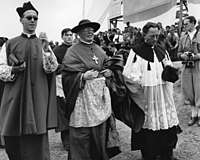
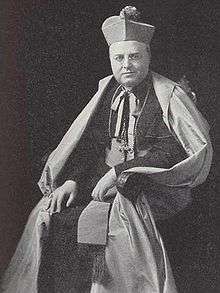
.jpg)
On 23 December 1945, Pope Pius XII announced he would create 32 cardinals at a consistory on 18 February 1946. The new cardinals came from 19 countries, with the number in the College of Cardinals from the Western Hemisphere growing from three to fourteen. Countries with their first cardinal included Australia, Chile, China, and Cuba. Only four were Italian. It was one of the largest groups of cardinals created at one time.[2][lower-alpha 1] Pius discussed the 70-member maximum, noting that it did not control his appointments, but said that he would adhere to it because he was already naming so many new cardinals.[lower-alpha 2] He said: "we have been anxious that the greatest number of races and peoples should be represented, so that this creation may portray in a living manner the universality of the church."[3] The size of the College had not been as high as 70–the maximum established on 3 December 1586 by Pope Sixtus V–since the eighteenth century.[3]
With this consistory, Italians became a minority in the College of Cardinals. When it was announced they were expected to hold 28 of the 70 places.[4] The death of Cardinal Pietro Boetto on 31 January at the age of 74[5] changed the outcome of the consistory to 27 Italians out of 69. As a symbolic recognition of the end of World War II, two of the new cardinals, Bernard Griffin from Great Britain and Konrad von Preysing of Germany embraced when they met on 12 February in the Vatican.[6] Agagianian, just 50, became the youngest member of the College, though his patriarch's title gave him precedence ahead of other cardinals created at this consistory.[7][lower-alpha 3]
The large number of new cardinals required moving the ceremony where the pope meets with the new cardinals from the papal apartments to the Hall of Benedictions, and for the public ceremony the papal throne was repositioned from the apse of St. Peter's Basilica to the steps of the Altar of Confession to allow for a larger crowd of spectators.[8] Three of the new cardinals were unable to attend the ceremonies on 18 February: Johannes de Jong and Jules-Géraud Saliège were unable to travel to Rome because of illness, and József Mindszenty was having problems obtaining a visa to travel from Hungary.[9] Mindszenty arrived for the public ceremony on 21 February, but José María Caro and Manuel Arteaga y Betancourt were suffering from influenza.[10] The next day, when the new cardinals received their rings, Juan Guevara was sick as well.[11] Arteaga and Guevara received their insignia in a private ceremony with Pius on 28 February.[12] Anticipating he would never be healthy enough to travel to Rome, de Jong received his biretta in Utrecht on 28 February as well.[12] Finally, Caro and Saliège received their insignia from Pius on 17 May.[13] By then the number of cardinals had fallen to 68 with the death of one of the new cardinals, John J. Glennon, on 9 March.[14]
- Grégoire-Pierre Agagianian (1895–1971)
- John J. Glennon (1862–1946)
- Benedetto Aloisi Masella (1879–1970)
- Clemente Micara (1879–1965)
- Adam Stefan Sapieha (1867–1951)
- Edward Mooney (1882–1958)
- Jules-Géraud Saliège (1870–1956)
- James Charles McGuigan (1894–1974)
- Samuel Stritch (1887–1958)
- Agustín Parrado y García (1872–1946)
- Clément-Emile Roques (1880–1964)
- Johannes de Jong (1885–1955)
- Carlos Carmelo Vasconcellos Motta (1890–1982)
- Pierre Petit de Julleville (1876–1947)
- Norman Thomas Gilroy (1896–1977)
- Francis Spellman (1889–1967)
- José María Caro (1866–1958)
- Teódosio de Gouveia (1889–1962)
- Jaime de Barros Câmara (1894–1971)
- Enrique Pla y Deniel (1876–1968)
- Manuel Arteaga y Betancourt (1879–1963)
- Josef Frings (1887–1978)
- Juan Guevara (1882–1954)
- Bernard Griffin (1899–1956)
- Manuel Arce y Ochotorena (1879–1948)
- József Mindszenty (1892–1975)
- Ernesto Ruffini (1888–1967)
- Konrad von Preysing (1880–1950)
- Clemens August Graf von Galen (1878–1946)
- Antonio Caggiano (1889–1979)
- Thomas Tien Ken-sin (1890–1967)
- Giuseppe Bruno (1875–1954)
12 January 1953
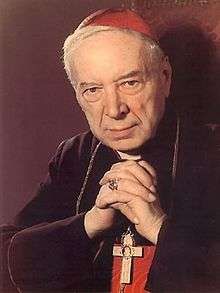
On 29 November 1952 Pope Pius XII announced he would create 24 new cardinals in a consistory on 12 January 1953. Eleven of them were Italian and the membership of the college would reach the maximum of 70, with 27 Italians. Two were thought to be virtual prisoners in their countries, Aloysius Stepinac in Yugoslavia and Stefan Wyszyński in Poland. Those from Ecuador and Colombia were those countries' first cardinals.[15] Stepinac and Wyszyński chose not to travel to Rome, fearing they would not be allowed to reenter their countries.[16]
One of those Pius named, Carlo Agostini, died on 28 December at the age of 64.[17] The next day, the Vatican announced Valerian Gracias would be made a cardinal, the first from India, allowing the College to reach its maximum membership of 70, with 26 of them Italian.[18]
Reviving a custom that had been interrupted, Pius announced that he was granting the request of Catholic heads of state in four countries to serve as his legate in delivering the cardinal's biretta to six of them, either residential bishops in or papal nuncios to their country: Generalissimo Francisco Franco of Spain for Gaetano Cicognani, Benjamín de Arriba y Castro, and Fernando Quiroga y Palacios; the socialist President of France Vincent Auriol for Angelo Giuseppe Roncalli;[19] the President of Portugal for Pietro Ciriaci; and President Luigi Einaudi of Italy for Francesco Borgongini Duca.[16][20][21] At the consistory Pius sharply criticized Yugoslavia and in milder language Poland and said the honor he was showing to two of their citizens was meant to honor their countries as well.[22][23]
When Pius died five years later, his failure to make Giovanni Battista Montini a cardinal at this conclave was much discussed. Though still in his fifties, Montini appeared to be groomed as Pius' successor and had long been his right hand at the Secretariat of State. Pius appointed him Archbishop of Milan in 1954, and Montini even received some votes at the 1958 conclave, where his prospects would have been very good had he been a cardinal. Instead he had to wait for the next conclave in 1963 to be elected Pope Paul VI.
- Celso Benigno Luigi Costantini (1876–1958)
- Augusto da Silva (1876–1968)
- Gaetano Cicognani (1881–1962)
- Angelo Giuseppe Roncalli (1881–1963) (Pope John XXIII; 1958–1963)
- Valerio Valeri (1883–1963)
- Pietro Ciriaci (1885–1966)
- Francesco Borgongini Duca (1884–1954)
- Maurice Feltin (1883–1975)
- Marcello Mimmi (1882–1961)
- Carlos María de la Torre (1873–1968)
- Aloysius Stepinac (1898–1960)
- Georges-François-Xavier-Marie Grente (1872–1959)
- Giuseppe Siri (1906–1989)
- John D'Alton (1882–1963)
- James McIntyre (1886–1979)
- Giacomo Lercaro (1891–1976)
- Stefan Wyszyński (1901–1981)
- Benjamín de Arriba y Castro (1886–1973)
- Fernando Quiroga y Palacios (1900–1971)
- Paul-Émile Léger (1904–1991)
- Crisanto Luque Sánchez (1889–1959)
- Joseph Wendel (1901–1960)
- Alfredo Ottaviani (1890–1979)
- Valerian Gracias (1900–1978)
Notes
- The New York Times cited [perhaps incorrectly] the 27 created at the consistory held by Pope Pius VII in 1801 as the largest.[2] Pius compared it to the 31 created by Pius VII in March 1816, though ten of those names were not announced at the time, and to the 31 created by Pope Leo X in the June 1517 consistory.[3]
- He said: Undoubtedly the Roman pontiffs who succeeded him [Sixtus V] would not be bound by this provision, if they considered it opportune to increase or diminish the number.... We have considered it all the more fitting not to go beyond the limit set, because there never yet has been created so large a number of Cardinals–thirty-two–in a single consistory."[3]
- For a complete list of the 67 [sic] members of the College as of March 1946 see: Epstein, M., ed. (1946). The Statesman's Year-Book: Statistical and Historical Annual of the States of the World for the year 1946. London: Macmillan and Co. pp. 1197–8.
References
- Noonan, James-Charles (2012). The Church Visible: The Ceremonial Life and Protocol of the Roman Catholic Church, Revised Edition. New York: Sterling Ethos. pp. 8–9. ISBN 978-1-40278730-0.
- Warren, Virginia Lee (24 December 1945). "Spellman Chosen to be a Cardinal; 31 Others Named" (PDF). New York Times. Retrieved 6 September 2017.
- Pope Pius XII (25 December 1945). "Text of Pope Pius' Address Outlining the Fundamentals for Effectuating Peace on Earth" (PDF). New York Times. Retrieved 6 September 2017.
- Warren, Virginia Lee (30 December 1945). "Choice of U.S. Pope Discussed in Rome" (PDF). New York Times. Retrieved 6 September 2017.
- "Cardinal Boetto, Foe of Nazis, Dies" (PDF). New York Times. 1 February 1946. Retrieved 6 September 2017.
- Brewer, Sam Pope (14 February 1946). "Briton and German in Vatican Reunion" (PDF). New York Times. Retrieved 6 September 2017.
- Lentz III, Harris M. (2002). Popes and Cardinals of the 20th Century: A Biographical Dictionary. MacFarland. p. 7. Retrieved 16 December 2017.
- Brewer, Sam Pope (18 February 1946). "Pope to Name 32 Prelates to the Cardinalate Today" (PDF). New York Times. Retrieved 6 September 2017.
- Brewer, Sam Pope (19 February 1946). "32 New Cardinals Notified of Titles in Vatican Rites" (PDF). New York Times. Retrieved 6 September 2017.
- Matthews, Herbert L. (22 February 1946). "Thousands Fill S. Peter's as Cardinals Get Red Hat" (PDF). New York Times. Retrieved 6 September 2017.
- Matthews, Herbert L. (23 February 1946). "Pius Gives Rings to New Cardinals" (PDF). New York Times. Retrieved 6 September 2017.
- Brewer, Sam Pope (1 March 1946). "Pope to Receive Spellman Today" (PDF). New York Times. Retrieved 6 September 2017.
- "2 Cardinals Get Hats in Private Consistory" (PDF). New York Times. 18 May 1946. Retrieved 6 September 2017.
- "Glennon Mourned by Church Leaders" (PDF). New York Times. 10 March 1946. Retrieved 6 September 2017.
- Cortesi, Arnaldo (30 November 1952). "24 New Cardinals Named by Vatican; American Included" (PDF). New York Times. Retrieved 6 September 2017.
- Cortesi, Arnaldo (10 January 1953). "M'Intyre in Rome for Cardinal Rite" (PDF). New York Times. Retrieved 6 September 2017.
- "Msgr. Agostini, 64, Succumbs in Italy" (PDF). New York Times. 28 December 1952. Retrieved 6 September 2017.
- "Prelate in India to be a Cardinal" (PDF). New York Times. 30 December 1952. Retrieved 6 September 2017.
- Pham, John-Peter (2004). Heirs of the Fisherman: Behind the Scenes of Papal Death and Succession. Oxford University Press. p. 69. Retrieved 17 September 2017.
- "Heads of 4 States to Vest Cardinals" (PDF). New York Times. 13 December 1952. Retrieved 6 September 2017.
- Cortesi, Arnaldo (12 January 1953). "Pope to Elevate Cardinals Today" (PDF). New York Times. Retrieved 6 September 2017.
- Cortesi, Arnaldo (13 January 1953). "24 Cardinals Invested by Pope Pius in Majestic Ceremonies at Vatican" (PDF). New York Times. Retrieved 6 September 2017.
- "Cardinals Vested by Pope in Ritual" (PDF). New York Times. 15 January 1953. Retrieved 6 September 2017.
- Additional sources
- Lentz III, Harris M. (2002). Popes and Cardinals of the 20th Century: A Biographical Dictionary. McFarland & Company. ISBN 978-0-7864-4101-3.
- Pope Pius XII (24 December 1945). "Negli ultimi anni" [In the course of the last six years] (in Italian). Libreria Editrice Vaticana. Retrieved 14 July 2018. Cite journal requires
|journal=(help)
